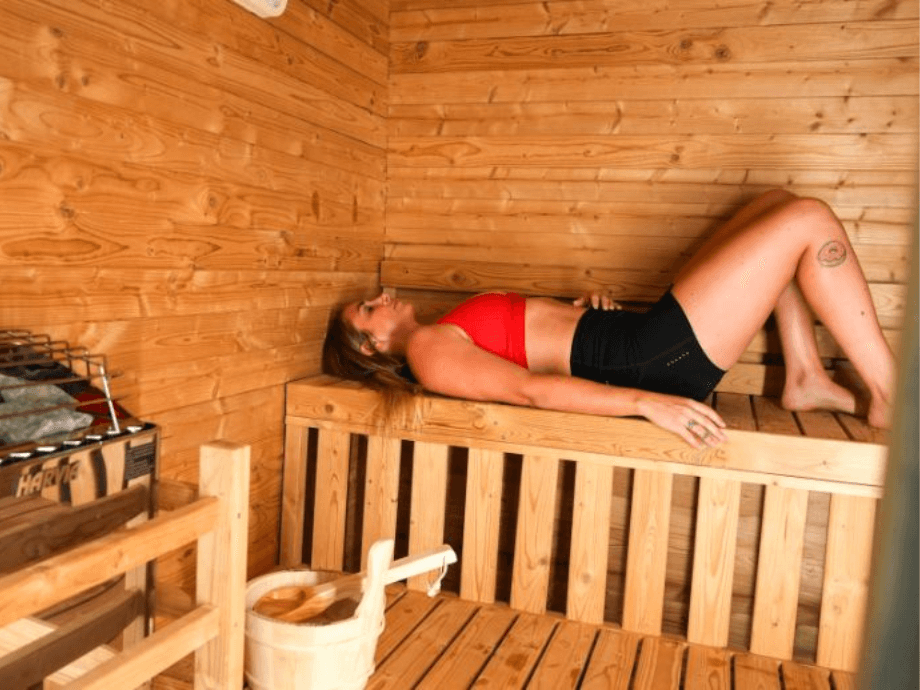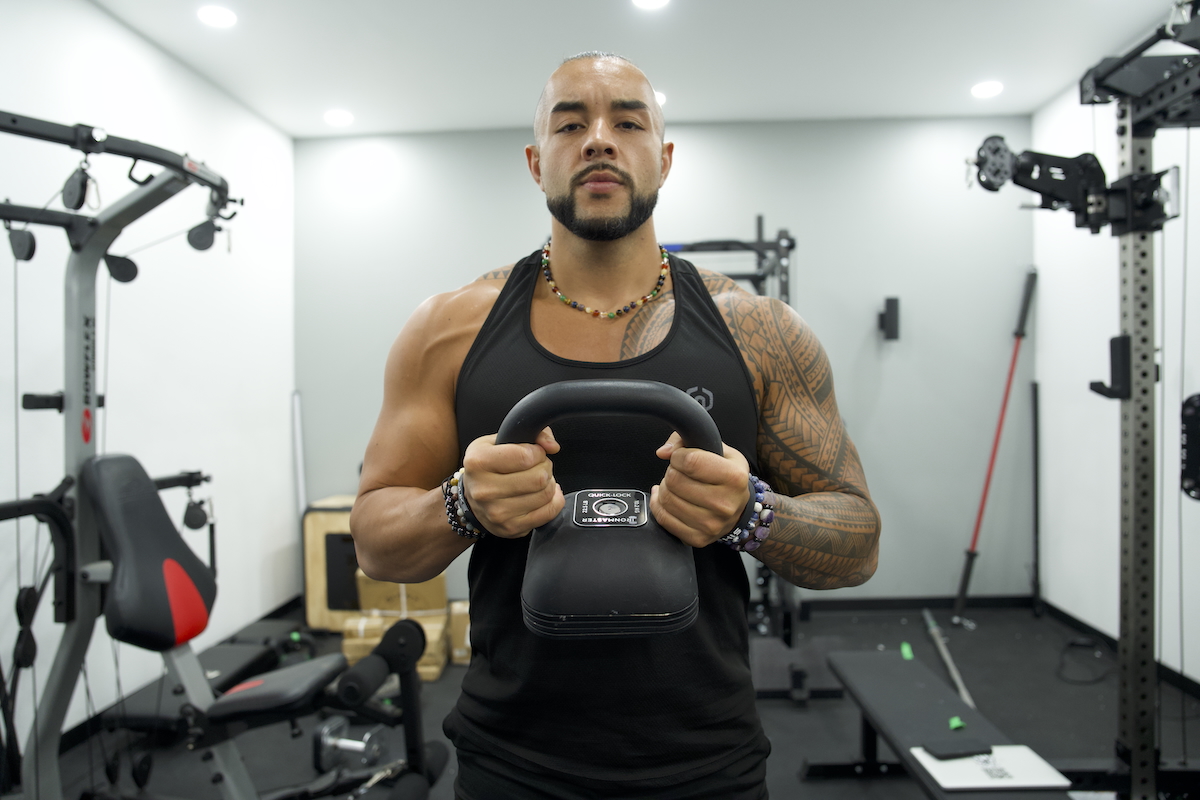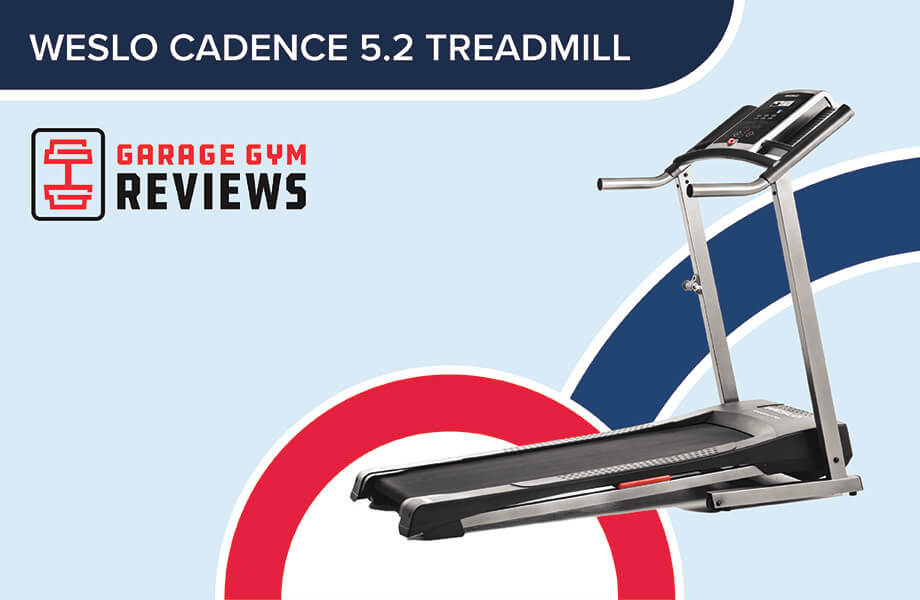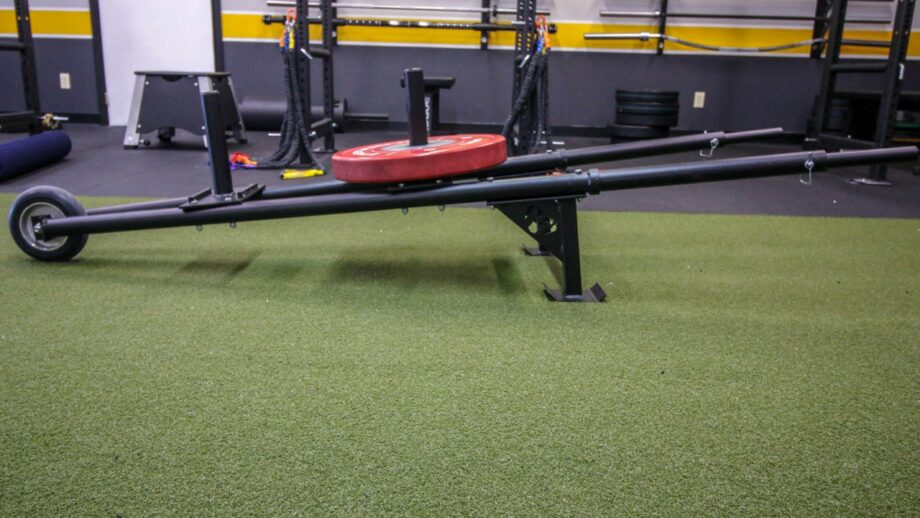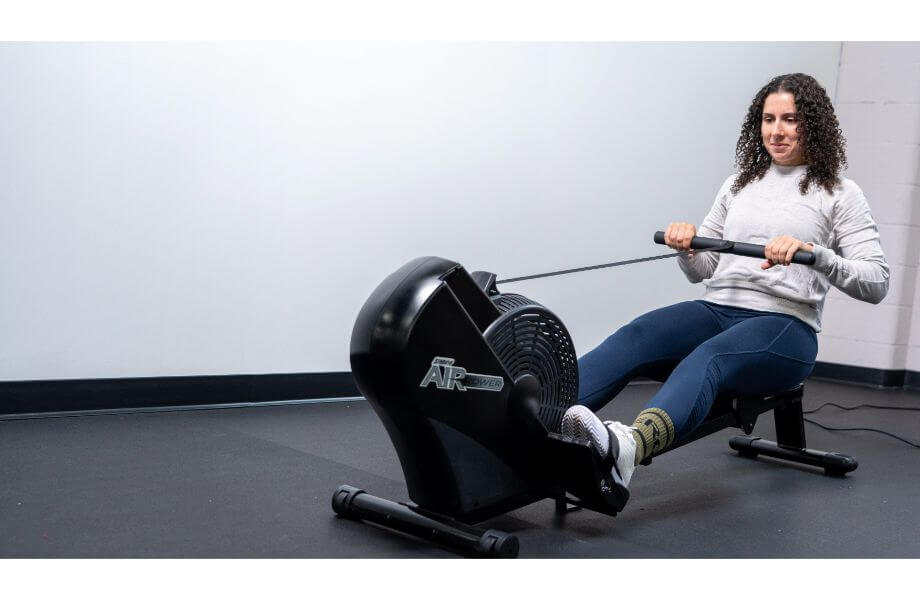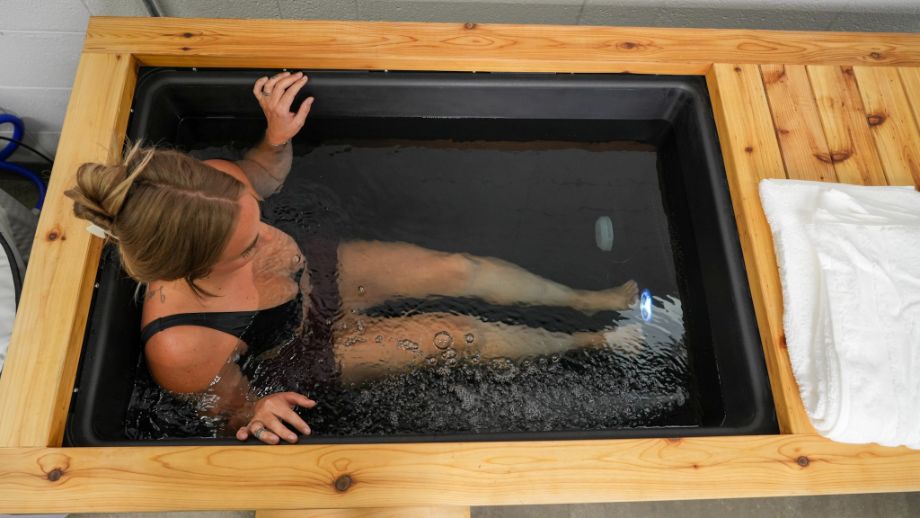Whether you’re stepping into a steamy traditional Finnish sauna, a modern infrared sauna with red light therapy panels, or an aromatic steam room with essential oils, your body and brain will thank you later. Synonymous with wellness and rejuvenation, sauna bathing can improve your cardiovascular health, promote detoxification, enhance blood circulation, and even increase your endorphins1.
The best home saunas allow you to enjoy these wide-ranging physical and mental health benefits without having to travel to a commercial gym or local spa. However, if you’re not familiar with how to use this muscle recovery tool, we’re here to help you break a serious sweat without overheating.
In this ultimate sauna guide, we’ll explore the different types of saunas, how to use them safely, and the science-backed health benefits of regular sauna sessions. Plus, we’ll provide safety tips to help ensure you reap the rewards and minimize any potential risks. Whether you’re designing a home sauna for an upcoming construction project, exploring outdoor sauna options, or just trying to find the right sauna for your lifestyle and budget, you can lean on our expertise to help create the perfect sauna experience.
Types of Sauna Experiences
While most research focuses on the traditional dry sauna (with long and celebrated histories in Nordic countries like Finland), there are other saunas types we’ll touch on here to lay the groundwork for general sauna use. Each sauna type can offer unique benefits, ambiance, and functionality, depending on your personal preference.
So, without further ado, let’s dive into the different types of saunas.
Dry Sauna
A traditional Finnish sauna is typically built from durable woods like cedar or hemlock and heated with an electric sauna heater or a wood-burning stove. These structures are often freestanding, generating intense heat ranging from 160 to 200 degrees Fahrenheit with humidity levels of just 10 to 20%.
RELATED: Best Wood for Saunas
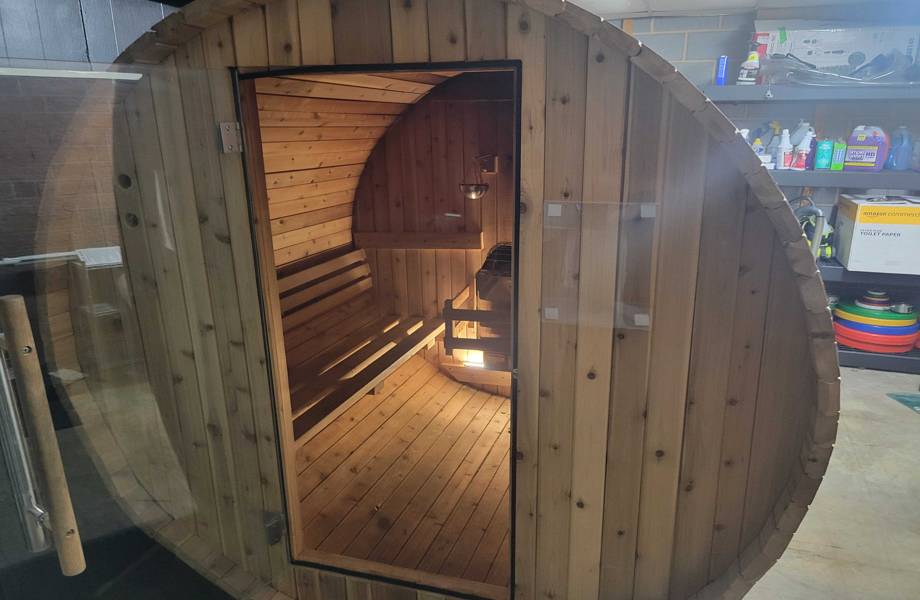
The heat source warms sauna stones placed atop the electric heater, allowing you to pour water over them to release steam (called löyly in Finnish), creating a brief burst of humidity. This function can enhance the sauna environment by making the air feel warmer, improving blood flow in the process as your body adapts to the heat. As someone who uses indoor saunas as part of my post-workout routine, I love ladling water over the hot stones, sitting back, and basking in the steamy goodness.
Steam Room
Steam rooms date back to ancient Roman and Greek cultures. Unlike dry saunas, they rely on water vapor produced by a steam generator to create a moist environment. Temperatures typically stay between 100 and 120 degrees Fahrenheit (lower than traditional saunas), but the humidity can reach a full 100%. This type of sauna experience can support skin hydration as well as detoxification, and is often enhanced with essential oils like eucalyptus for added aromatherapy2 benefits.
RELATED: Steam Room Benefits
Infrared Sauna
Infrared saunas work by using infrared heat units that emit an infrared light, which can quickly heat your body without heating the air. These types of saunas run at lower temperatures, ranging from 120 to 150 degrees Fahrenheit, and do not produce vapor, humidity, or scent. Because of their compact sauna design and energy efficiency, many of the best infrared saunas can be ideal picks for regular home use.
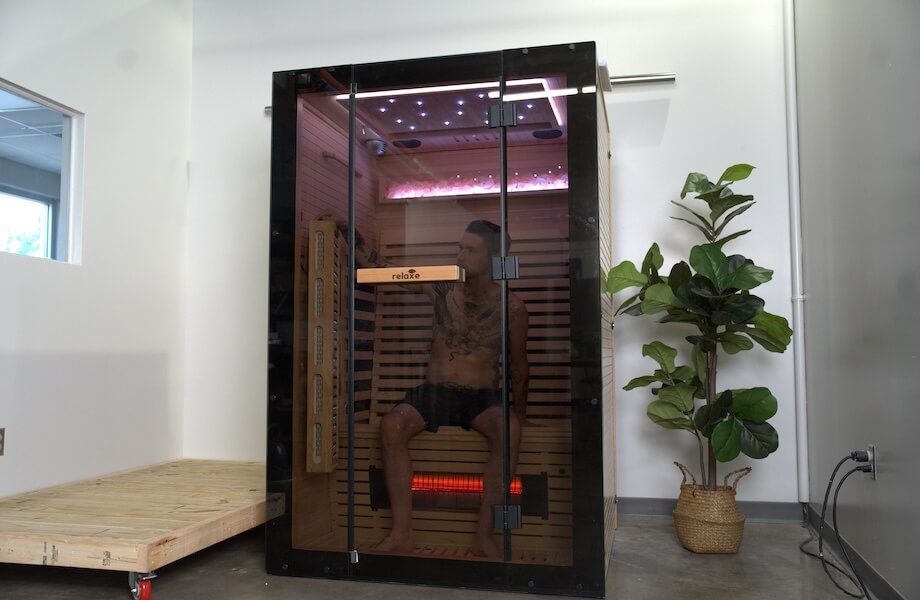
How to Use a Sauna
According to the North American Sauna Society, the traditional sauna experience is meant to be relaxing and social. The society recommends taking your time and allowing up to two hours for a sauna bathing session. Sauna sessions consist of intermittent sauna use, cold showers, and making sure to drink plenty of water.
Here is the Sauna Society’s how-to guide on enjoying a traditional Finnish sauna:
- Hydrate with one or two glasses of water before starting your first sauna session.
- Rinse off in the shower before getting into the sauna (rinsing off in a swimsuit is fine).
- Warm yourself up in the dry sauna, ladling water over the sauna rocks for vapor, as desired, until you start perspiring, which typically occurs at about 8 to 10 minutes.
- After your first sweat, leave the sauna for another rinse in the shower.
- Allow your body temperature to cool down and rest. Drinking another glass of water is recommended at this stage, too.
- Re-enter the sauna for another 8 to 10 minutes, pouring water on the sauna rocks as desired.
- Upon the second visit in the sauna, you can use the traditional vihta whisk (an arrangement of dried birch and twigs used to gently beat and massage the skin).
- Exit the sauna again and wash off in the shower.
- Have another glass of water to cool down and rest outside the sauna.
- Re-enter the sauna for your last 8 to 10 minute session.
- End the session by exiting the sauna for a cool bath, shower, or swimming, if possible.
- Allow time to rest and relax after by sitting or lying down.
- Drink another glass of water or something refreshing and pair it with a light snack.
Once you stop sweating and feel cooled down, you can get dressed and end your session. Expect to feel relaxed and refreshed in that post-sauna window.
If you don’t have the time or interest in such a lengthy session, you can try a more basic approach post-workout or as part of your morning routine. Start by entering the sauna once it’s fully heated—usually between 160 to 190 degrees Fahrenheit—and sit or recline comfortably. Focus on slow, steady breathing, and allow your body to gradually adjust to the heat.
“Keep sauna sessions to 15 to 20 minutes and pay attention to how you’re feeling,” says GGR chief medical advisor Dr. Raj Dasgupta, MD, FACP, FCCP, FAASM. “Stay hydrated before, during, and after, and avoid going in on an empty stomach or right after intense exercise. If you start to feel dizzy or overheated, step out and cool down—it’s not worth pushing it.”
Dry Sauna Benefits
As it turns out, several dry sauna benefits do have a scientific basis—at least, a moderate one. In particular, saunas are thought to positively impact heart health, athletic performance, muscle soreness, pain associated with certain diseases, skin health, and mood.
Possible Positive Effect on Heart Health
One of the most widely cited health benefits of saunas is improved cardiovascular health.
A 2018 literature review from Mayo Clinic Proceedings3 reports that, “Emerging evidence suggests that sauna bathing has several health benefits, which include reduction in the risk of vascular diseases such as high blood pressure, cardiovascular disease (CVD), stroke, and neurocognitive diseases.”
Additional research supports this, including a 2018 systematic review in Evidence-Based Complementary and Alternative Medicine4, in which authors also say sauna use is associated with a lower risk of heart failure, sudden cardiac death, and all-cause mortality (death from any cause).
If you already have any form of heart disease, including if you’ve recently had a heart attack, it’s imperative to talk to your doctor before using a sauna. People with high or low blood pressure should also talk to their healthcare provider before use.
RELATED: Sauna Maintenance Tips
Might Improve Athletic Performance
One profound benefit of dry saunas is exercise performance, particularly endurance performance. In a small 2007 trial5, runners who sat in a sauna for about 30 minutes after running experienced an increase in time to exhaustion by more than 30%. According to the research, this effect is likely due to an increase in blood volume.
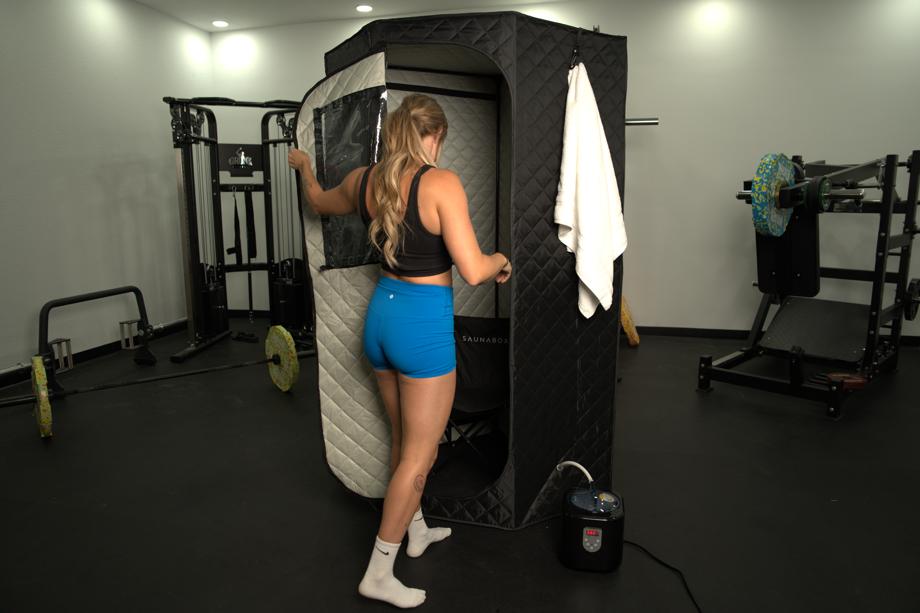
Another study6 concluded that sauna use is an “effective ergogenic aid” and a worthwhile tool for heat acclimatization, showing that runners who used the sauna had lower core temperature readings during a heat tolerance test compared to runners who did not use the sauna.
Relieves Muscle Soreness and Tightness
Feeling achy, tight, or sore? A sauna session might help.
Research7 has shown that sauna bathing can increase the amount of anti-inflammatory proteins after exercise. One study8 also found that people who used saunas regularly had lower levels of an inflammatory molecule (C-reactive protein) in their blood, so the anti-inflammatory benefits may be twofold.
Additionally, researchers have proposed9 that due to vasodilation (widening of the blood vessels) and increased blood flow, saunas may reduce muscle soreness post-exercise.
Relieves Symptoms Associated With Rheumatic Diseases
The aforementioned 2018 systematic review in Evidence-Based Complementary and Alternative Medicine4 found that sauna use may also alleviate pain from rheumatoid arthritis, fibromyalgia, and other rheumatic conditions (conditions that affect joints, tendons, ligaments, bones, and muscles).
Can Relieve Anxiety and Lift Mood
Evidently, sauna health benefits include improved mental health, too. The science isn’t as strong here, but some research does correlate sauna use and reduced depression, anxiety, and fatigue.
In one small controlled trial10 from 2005, 28 patients with mild depression and low appetite were split into two groups: sauna therapy and no sauna therapy. After four weeks, the participants who used the sauna for 15 minutes per day, five days per week, reported increased appetite and relaxation.
Another study from 201511 investigated the effects of regular sauna use on patients with chronic fatigue syndrome. The patients reported significantly lower fatigue during (but not after) dry sauna sessions, as well as lower levels of anxiety and depression.
Might Help You Sleep
Because of its positive effects on mood and anxiety, sitting in a sauna may also help you catch more Zzzs, which we all know is important for overall well-being. In 2019, researchers published the results of a survey about sauna benefits12. Of nearly 500 respondents, more than 80% reported that using a sauna before bed helped them sleep better.
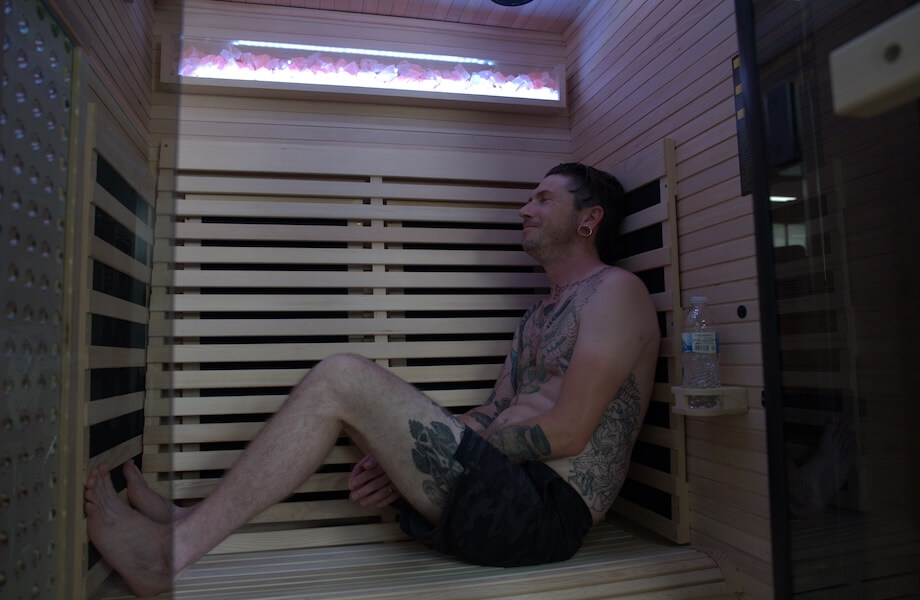
How Long Should You Stay In a Sauna?
Spending time in a sauna or steam room can be very therapeutic. It’s quintessentially relaxing, serving as a method for melting away stress or jumpstarting muscle recovery after a tough workout while also providing a plethora of health benefits.
The sauna, unfortunately, isn’t strictly positive. There are risks and dangers associated with sauna use, specifically overuse, that can create life-threatening conditions. As such, it’s important to keep your sauna session to an appropriate length for safety reasons.
So, exactly how long should you stay in a sauna to enjoy the many health benefits without putting yourself at risk? Dr. Michael Masi, DPT, answers this question to ensure you enjoy your sauna sessions safely.
Less Is More
“The longer you stay in a sauna, the greater your risk of dehydration is,” says Dr. Masi. “That’s why most studies on the effects of sauna use generally limit sauna session duration to no more than 20 minutes at a time.”
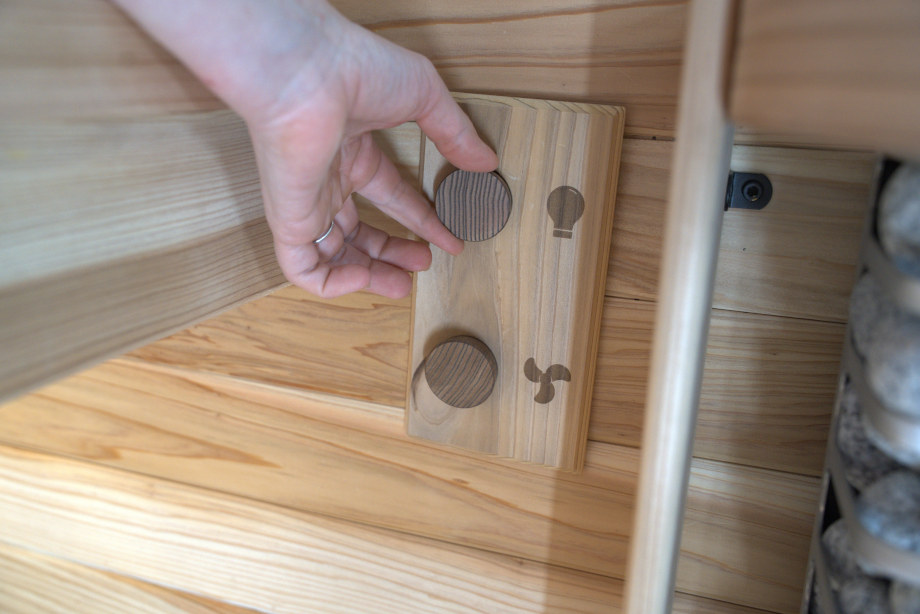
If you are a seasoned sauna user, spending approximately 10 to 15 minutes is considered adequate for receiving health benefits while keeping risks relatively low.
For Beginners
Beginners may not be as accustomed to the high temperatures of home saunas, which can range between 110 and 200 degrees Fahrenheit, depending on which type of sauna you’re using.
RELATED: Steam Room vs Sauna
“The best way to acclimate is to start small and build,” says Dr. Masi. “For beginners, I recommend no longer than 5- or 10-minute sessions, focusing on hydration at all times. And, as a general rule, you should never stay in the sauna if you feel like it’s too much.”
After a Workout
Sitting in the sauna after a workout can yield some sport-specific benefits that are hard to ignore.
For example, a 2015 study in SpringerPlus13 determined that sauna bathing, through use of either a traditional Finnish sauna or far infrared sauna, had a positive effect on “neuromuscular system [recovery after] maximal endurance performance.”
A 2023 study in Biology of Sport14 corroborated these findings, noting that male basketball players who participated in infrared sauna bathing as part of a post-exercise regimen showed improvements in their explosive performance, diminished muscle soreness and inflammation, and mental health benefits, including improved mood, increased morale, and a greater feeling of preparedness.
“Experienced sauna bathers are welcome to sit in the sauna for 15 to 20 minutes at a time,” says Dr. Masi, “But I recommend waiting at least 10 minutes after exercise before subjecting yourself to further sweating. Take that time to cool down and drink plenty of water, so your risk of adverse effects is minimal once you get in there.”
Benefits of Sauna After Workouts
After a long, tough workout, the last thing you want to do is continue sweating for another 20 minutes. However, as we started to dive into above, there are many benefits to spending time in a sauna post-exercise, including:
May Help Reduce Inflammation
After a heavy session of strength training, sore muscles can be inflamed, as well as joints, ligaments, and tendons. Using a sauna post-workout can help reduce that inflammation.
According to a 2018 study8, people who used a sauna were shown to have lower CRP (C-reactive protein) levels than those who didn’t. CRP is a blood protein used in inflammatory responses, and these levels decreased the more frequently the sauna was used.

Sauna use can also boost anti-inflammatory proteins, like IL-10, according to another study from the same year7. In the study, anti-inflammatory proteins significantly increased in people after four weeks of consistent sauna usage.
May Help Improve Muscle Recovery
Nothing would help more after a tough workout than to jumpstart your recovery for the next day. A small study from July 202314 showed that infrared sauna use could do just that. In this study, basketball players did 20 minutes of passive recovery or a 20-minute session in an infrared sauna. The study found that most sauna users felt more recovered and perceived less muscle soreness.
Another study from 201415 demonstrated that a single use of a Finnish sauna after aerobic exercise was able to reduce the oxidative stress caused by the workout significantly. Less stress on the body allows for more recovery.
May Help Improve Cardiovascular Health
The stress caused by the heat of the sauna can help improve your cardio performance and health. Saunas are a relatively safe, controlled way to train your cardiovascular performance. As the temperature of the sauna increases, your heart rate increases16, as well, up to levels comparable to moderate or vigorous exercise.

Although this causes stress initially, it appears to also relieve that cardiovascular stress, as seen in an August 2019 study17. In this report, athletes’ heart rates were lower after recovery from the sauna than their normal baseline prior to sauna use.
May Help Reduce Blood Pressure
Along with cardiovascular health, saunas have been shown to reduce your blood pressure. A small study in 201918 took the blood pressure of 19 individuals before, during, and 30 minutes after sauna use. In that study, the participants’ heart rates and blood pressure increased while in the sauna, but were lower than their baseline after recovery.
RELATED: Does Cardio Lower Blood Pressure?
May Help You Sleep Better
In addition to reducing heart rate and increasing blood flow, saunas after working out can be relaxing to the right person, too. A sauna session in the evening after training can help you relax before bed. In a survey from a 2019 June study19, 83.5% of nearly 500 participants reported sleep benefits after sauna use.
May Help Release Toxins
If you didn’t know, saunas can make you sweat. The average person loses about 0.5 kilograms of sweat20 during a sauna bath—equivalent to roughly 1.1 pounds. A Mayo Clinic review2 also notes that the increased body temperature from dry saunas increases blood circulation and blood flow to the skin, which helps facilitate sweating.
Your body can excrete toxins through sweat and sauna use, such as BPAs21, heavy metals22, and polychlorinated biphenyls (PCBs)23. It’s important to note that these toxins are excreted through blood and urine as well as through sweat, though. But if you’re looking for a way to detox and help your skin, a sauna might do the trick.

May Help Aid In Weight Loss
A sauna session may help in weight loss, though not in the way you might think. Due to the amount of sweat that can be lost in a single sauna session, saunas can cause rapid weight loss, where a person can lose a few pounds20 after a single session—although the weight lost is almost all water weight.
This is a common practice for athletes in a sport divided by weight classes, so that an athlete can be under a weight in time of competition while retaining as much muscle mass as possible. Keep in mind; these athletes are also supervised by professionals and experts while cutting weight, and this method should not be attempted by regular individuals.
RELATED: Sauna for Weight Loss
Still, the heat stress of a sauna can certainly burn more calories than being sedentary. A January 2019 study24 showed that considerably more calories were burned during sauna use than just doing nothing, which resulted in significant weight loss in overweight men.
While research is scarce on whether or not sauna use can really help with weight loss, the stress relief and increased metabolism of sauna use can certainly aid in potential weight loss, especially when paired with routine exercise.
RELATED: Best Protein Powder for Weight Loss
May Help Improve Mental Health
The higher temperatures of a dry sauna after a workout have been shown to help with your mental health and stress relief, as well. A study from 201725 showed that both heat stress and exercise can increase brain-derived neurotrophic factor, or BDNF—a protein in the central and peripheral nervous systems. BDNF has lots of benefits to brain function, including memory function and handling anxiety and depression, as noted from a 2010 study26 with male rats.
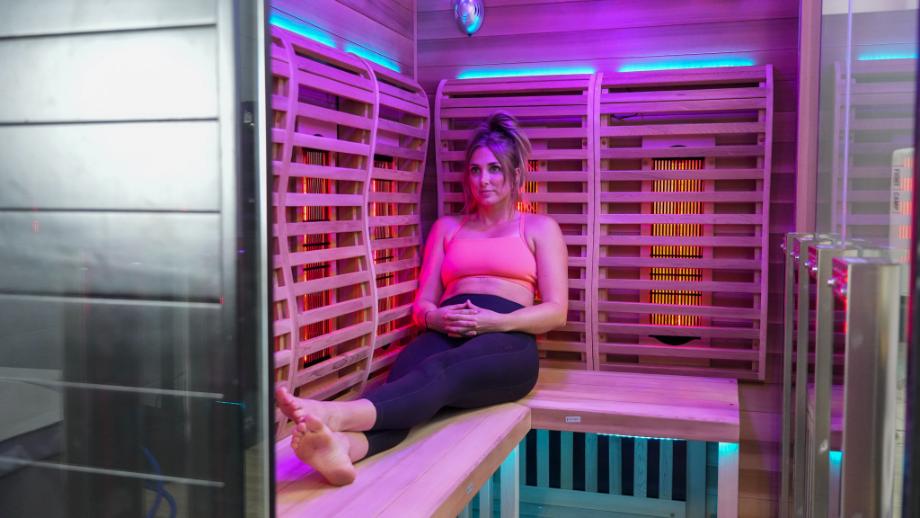
Sauna Safety Precautions
While there are plenty of research-backed benefits, there are also risks associated with sauna usage. To ensure a safe and enjoyable experience, follow these precautions:
- Limit time in the sauna: Most sauna guidelines recommend staying in the sauna for a maximum of 15 minutes.
- Use intervals for longer sessions: If you want to sauna bathe for longer periods, take breaks to cool off every 15 minutes. Exit the sauna and allow your body to cool down before re-entering, making sure to replenish fluid levels in-between sweats.
- Do not exercise in the sauna: While some gentle stretching in a sauna is usually well-tolerated, it’s not advisable to exercise in the sauna. This can increase sweat rate and heart rate even more, and can cause you to become dizzy or lightheaded. If you ever experience that, exit the sauna or lower the temperature immediately.
- Bring water to drink: Saunas cause you to sweat, sometimes a lot, so make sure to drink plenty of water. We also recommend adding one of the best electrolyte powders to your water to replace key minerals lost via sweat.
RELATED: Sauna Etiquette
Who Should Not Use a Sauna
Furthermore, there are some instances where you should not use a sauna. If any of these apply, check with a doctor first before adding sauna sessions to your wellness routine.
- You are prone to lightheadedness, dizziness, or fainting
- You are dehydrated
- You are under the influence of alcohol or any drugs
- You are pregnant or nursing (talk to your obstetrician)
- You have a fever or are sick with a bacterial or viral infection
- You have cardiovascular disease
- You have low or high blood pressure
- You get seizures or have a seizure disorder
- You have another medical condition that might affect your ability to withstand high temperatures
Overall, it’s better to be too cautious and get clearance rather than be too cavalier and put your health at risk. Remember: Safety should always be your top priority when it comes to training and recovery.
Ultimate Sauna Guide: Final Thoughts
As a self-proclaimed sauna enthusiast, I’ll be the first to sing the praises of this muscle recovery method. At the same time, I’m fully aware of the risks that come with improper or excessive sauna use. That said, this ultimate guide is exactly the resource you need to fully understand how to make the most of every minute of each and every sauna session.
Ultimate Sauna Guide: FAQs
How does a traditional sauna differ from an infrared sauna?
A traditional sauna heats the air with stones or steam to warm your body, while an infrared sauna uses infrared light to heat your body directly at a lower temperature and humidity level.
What temperature should a traditional Finnish sauna be?
A traditional Finnish sauna should be between 150 and 190 degrees Fahrenheit (65 to 90 degrees Celsius). You can increase the humidity by pouring water over the available sauna stones.
Which is better: a steam room or sauna?
While neither is necessarily “better” than the other, there are some distinct differences to consider. A dry or infrared sauna typically provides more intense heat for muscle relaxation and circulation. On the other hand, a steam room can offer high humidity levels that can support skin hydration and respiratory health.
References
- Chang, M., Ibaraki, T., Naruse, Y., & Imamura, Y. (2023). A study on neural changes induced by sauna bathing: Neural basis of the “totonou” state. PloS one, 18(11), e0294137. https://doi.org/10.1371/journal.pone.0294137
- Farrar, A. J., & Farrar, F. C. (2020). Clinical aromatherapy. Nursing Clinics of North America, 55(4), 489–504. https://pmc.ncbi.nlm.nih.gov/articles/PMC7520654/
- Laukkanen, J. A., Laukkanen, T., & Kunutsor, S. K. (2018). Cardiovascular and other health benefits of sauna bathing: A review of the evidence. Mayo Clinic Proceedings, 93(8), 1111-1121. https://doi.org/10.1016/j.mayocp.2018.04.008
- Hussain, J., & Cohen, M. (2018). Clinical Effects of Regular Dry Sauna Bathing: A Systematic Review. Evidence-based complementary and alternative medicine : eCAM, 2018, 1857413. https://doi.org/10.1155/2018/1857413
- Scoon, G. S., Hopkins, W. G., Mayhew, S., & Cotter, J. D. (2007). Effect of post-exercise sauna bathing on the endurance performance of competitive male runners. Journal of science and medicine in sport, 10(4), 259–262. https://doi.org/10.1016/j.jsams.2006.06.009
- Kirby, N. V., Lucas, S. J. E., Armstrong, O. J., Weaver, S. R., & Lucas, R. A. I. (2021). Intermittent post-exercise sauna bathing improves markers of exercise capacity in hot and temperate conditions in trained middle-distance runners. European journal of applied physiology, 121(2), 621–635. https://doi.org/10.1007/s00421-020-04541-z
- Żychowska, M., Nowak-Zaleska, A., Chruściński, G., Zaleski, R., Mieszkowski, J., Niespodziński, B., Tymański, R., & Kochanowicz, A. (2018). Association of High Cardiovascular Fitness and the Rate of Adaptation to Heat Stress. BioMed research international, 2018, 1685368. https://doi.org/10.1155/2018/1685368
- Laukkanen, J. A., & Laukkanen, T. (2018). Sauna bathing and systemic inflammation. European journal of epidemiology, 33(3), 351–353. https://doi.org/10.1007/s10654-017-0335-y
- Khamwong, P., Paungmali, A., Pirunsan, U., & Joseph, L. (2015). Prophylactic Effects of Sauna on Delayed-Onset Muscle Soreness of the Wrist Extensors. Asian journal of sports medicine, 6(2), e25549. https://doi.org/10.5812/asjsm.6(2)2015.25549
- Masuda, A., Nakazato, M., Kihara, T., Minagoe, S., & Tei, C. (2005). Repeated thermal therapy diminishes appetite loss and subjective complaints in mildly depressed patients. Psychosomatic medicine, 67(4), 643–647. https://doi.org/10.1097/01.psy.0000171812.67767.8f
- Soejima, Y., Munemoto, T., Masuda, A., Uwatoko, Y., Miyata, M., & Tei, C. (2015). Effects of Waon therapy on chronic fatigue syndrome: a pilot study. Internal medicine (Tokyo, Japan), 54(3), 333–338. https://doi.org/10.2169/internalmedicine.54.3042
- Hussain, J. N., Greaves, R. F., & Cohen, M. M. (2019). A hot topic for health: Results of the Global Sauna Survey. Complementary therapies in medicine, 44, 223–234. https://doi.org/10.1016/j.ctim.2019.03.012
- Mero, A., Tornberg, J., Mäntykoski, M., & Puurtinen, R. (2015). Effects of far-infrared sauna bathing on recovery from strength and endurance training sessions in men. SpringerPlus, 4, 321. https://doi.org/10.1186/s40064-015-1093-5
- Ahokas, E. K., Ihalainen, J. K., Hanstock, H. G., Savolainen, E., & Kyröläinen, H. (2023). A post-exercise infrared sauna session improves recovery of neuromuscular performance and muscle soreness after resistance exercise training. Biology of sport, 40(3), 681–689. https://doi.org/10.5114/biolsport.2023.119289
- Sutkowy, P., Woźniak, A., Boraczyński, T., Mila-Kierzenkowska, C., & Boraczyński, M. (2014). The effect of a single Finnish sauna bath after aerobic exercise on the oxidative status in healthy men. Scandinavian journal of clinical and laboratory investigation, 74(2), 89–94. https://doi.org/10.3109/00365513.2013.860616
- Taggart, P., Parkinson, P., & Carruthers, M. (1972). Cardiac responses to thermal, physical, and emotional stress. British medical journal, 3(5818), 71–76. https://doi.org/10.1136/bmj.3.5818.71
- Laukkanen, T., Lipponen, J., Kunutsor, S. K., Zaccardi, F., Araújo, C. G. S., Mäkikallio, T. H., Khan, H., Willeit, P., Lee, E., Poikonen, S., Tarvainen, M., & Laukkanen, J. A. (2019). Recovery from sauna bathing favorably modulates cardiac autonomic nervous system. Complementary therapies in medicine, 45, 190–197. https://doi.org/10.1016/j.ctim.2019.06.011
- Ketelhut, S., & Ketelhut, R. G. (2019). The blood pressure and heart rate during sauna bath correspond to cardiac responses during submaximal dynamic exercise. Complementary therapies in medicine, 44, 218–222. https://doi.org/10.1016/j.ctim.2019.05.002
- Hussain, J. N., Greaves, R. F., & Cohen, M. M. (2019). A hot topic for health: Results of the Global Sauna Survey. Complementary therapies in medicine, 44, 223–234. https://doi.org/10.1016/j.ctim.2019.03.012
- Podstawski, R., Boraczyński, T., Boraczyński, M., Choszcz, D., Mańkowski, S., & Markowski, P. (2014). Sauna-induced body mass loss in young sedentary women and men. The Scientific World Journal, 2014, 307421. https://doi.org/10.1155/2014/307421
- Genuis, S. J., Beesoon, S., Birkholz, D., & Lobo, R. A. (2012). Human excretion of bisphenol A: blood, urine, and sweat (BUS) study. Journal of environmental and public health, 2012, 185731. https://doi.org/10.1155/2012/185731
- Genuis, S. J., Birkholz, D., Rodushkin, I., & Beesoon, S. (2011). Blood, urine, and sweat (BUS) study: monitoring and elimination of bioaccumulated toxic elements. Archives of environmental contamination and toxicology, 61(2), 344–357. https://doi.org/10.1007/s00244-010-9611-5
- Genuis, S. J., Beesoon, S., & Birkholz, D. (2013). Biomonitoring and Elimination of Perfluorinated Compounds and Polychlorinated Biphenyls through Perspiration: Blood, Urine, and Sweat Study. ISRN toxicology, 2013, 483832. https://doi.org/10.1155/2013/483832
- Podstawski, R., Borysławski, K., Clark, C. C. T., Choszcz, D., Finn, K. J., & Gronek, P. (2019). Correlations between Repeated Use of Dry Sauna for 4 x 10 Minutes, Physiological Parameters, Anthropometric Features, and Body Composition in Young Sedentary and Overweight Men: Health Implications. BioMed research international, 2019, 7535140. https://doi.org/10.1155/2019/7535140
- Kojima, D., Nakamura, T., Banno, M., Umemoto, Y., Kinoshita, T., Ishida, Y., & Tajima, F. (2018). Head-out immersion in hot water increases serum BDNF in healthy males. International journal of hyperthermia : the official journal of European Society for Hyperthermic Oncology, North American Hyperthermia Group, 34(6), 834–839. https://doi.org/10.1080/02656736.2017.1394502
- Maniam, J., & Morris, M. J. (2010). Voluntary exercise and palatable high-fat diet both improve behavioural profile and stress responses in male rats exposed to early life stress: role of hippocampus. Psychoneuroendocrinology, 35(10), 1553–1564. https://doi.org/10.1016/j.psyneuen.2010.05.012






